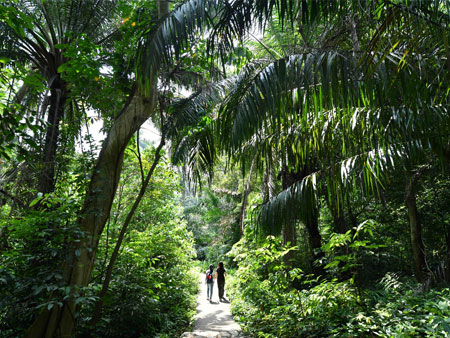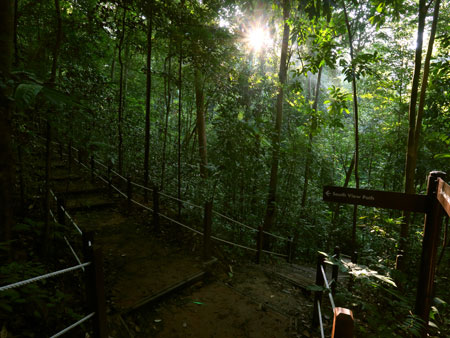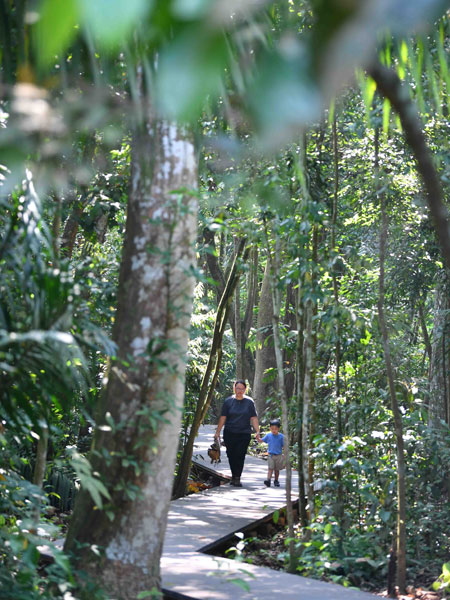Enjoying Nature Responsibly

Love our flora and fauna? Want to help conserve our precious biodiversity? Many still have the impression that biodiversity conservation requires us to give up a certain way of life. In fact, nothing can be further from the truth.
Faced with the increasing rate of urban and economic development, a small country such as Singapore has only so much land to dedicate as habitats for our flora and fauna. It is a delicate balance we must constantly strive to achieve between the needs of our population and the need to conserve our native biodiversity.
Unbeknownst to many, simple actions can go a long way in helping to protect our natural heritage. A particularly effective way is to start by being a responsible visitor when visiting our nature parks and nature reserves by observing these simple practices.
Visit From 7 am to 7 pm

When the sun sets, it is also time to leave nature parks and nature reserves.
Nature reserves, particularly nature parks, offer visitors a gentle interface between humans and nature, particularly giving the young, old and un-initiated a taste of nature in their own backyard.
The terrain in nature parks and nature reserves is similar – both feature the undulating and uneven surfaces characteristic of the natural environment, integrating sections of man-made stairs and boardwalks with natural rock and dirt tracks. These different sections make the trails unsuitable and potentially hazardous for activities such as night walks and night photography.
Aside from concerns over personal safety, the well-being of our biodiversity is also a key priority. When visitors disturb the animals or their habitats, the animals have little choice but to leave the safety of their refuge and venture into unknown dangers outside of the nature parks and reserves. In doing so, many end up as road kills.
This explains why we do not allow visitors in our nature parks and nature reserves during 7 pm to 7 am where there is no lighting provided. Nocturnal animals thrive under the cover of darkness. Their highly sensitive eyes enable them to survive in low light conditions or even absolute darkness. Studies have shown that the light intensity required for visual cell damage in nocturnal animals needs to be only two to three times above normal room lighting.
These “closing hours” also minimise anthropogenic, or human-made, disturbances to our biodiversity, providing them with much needed rest and reprieve. Such restrictions enable them to resume the natural behaviours necessary for their survival instead of expending energy to hide from visitors or avoid areas prone to human disturbances.
Do Not Use Flash Photography

Animals thrive under the cover of darkness and bright lights such as flash photography can disturb them. Here is a family of Asian Small-clawed Otters moving about in the night.
While we may commonly use high-tech gadgets such as intensely bright LED headlamps to navigate in the dark, animals caught in a beam of blinding light can stand “frozen” in fear and are unable to flee in time to avoid danger. Instead, left with the option of self-preservation, larger animals may naturally charge at perceived threats and injure humans in the process, resulting in being unfairly labelled as a danger to public safety. Sometimes there are even suggestions that the animals be put down for displaying their natural behaviour.
Flashes from night photography can produce similar “fight” consequences and cause damage to the sensitive eyes of nocturnal animals, leaving them vulnerable to predators. Moreover, animals often rely on environmental cues such as moonlight to guide their movement and behaviours. Bright lights can thus confuse their natural rhythms.
Stay on Designated Trails

Do stay on designated trails while visiting our nature parks and nature reserves.
The populations of our flora and flora are relatively stable on our small island nation due largely to the stringent regulations protecting sensitive core areas by restricting human access to these areas.
When we wander off designated trails, we put our native biodiversity at risk by directly disturbing them or indirectly disturbing their habitats. By entering restricted areas, human leave our scent behind. Animals may then detect this and perceive it as a threat, potentially negatively impacting their natural behaviour and movement.
For example, to avoid such a perceived threat, the animal may choose to move away from an area that is actually ideal as a habitat. Doing so requires it to re-channel energy that could have been originally reserved for reproduction. As a result, this may negatively impact the survival rate of the animal, its progenies and the sustainability of the population as a whole.
Reduce Noise Level

Whether you visit solo or in large groups, keep your volume down and soak in the sounds of nature instead.
Large groups visiting nature parks and nature reserves tend to generate a significant level of noise. Individuals listening to loud music over wireless Bluetooth speakers can also produce noise levels similar to that generated by large groups.
Such noises result in an environment that is not conducive for communication between or amongst species. Animals may avoid the area and expend energy to look for alternative habitats, energy that could have been better used in activities that increase their survival rate, such as searching for food, caring for their off springs and maintaining good health.
Animals produce calls to warn each other or to socialise. If they are unable to do so, they may very well miss an auditory signal sent by members of their own species to warn others of a predator or other dangers nearby. Equally detrimental, the animal could miss an opportunity to attract a mate and ensure the transfer of genes to the next generation.
Remove Nothing Except Trash

Enjoy the sights in our nature parks and nature reserves, but take nothing out except memories and your trash.
When we remove fruits, flowers or any products from our forest, we are depriving our native biodiversity of nourishment and materials necessary for their survival.
Edible fruits such as durians are an important source of diet for our fauna. When these fruits are removed from the forest for human consumption, we essentially reduce the amount of food available to our native wildlife. Consequently, they are forced to forage outside of their natural habitats and often enter into urban areas in search of food. An increase in human-wildlife conflicts, more often than not, leads to some not-so-happy endings for our wildlife.
Many more trail etiquettes are highlighted at the entrances of our nature parks and reserves but a common thread to all such advisories is the need to minimise disturbances to our precious native biodiversity. By heeding them, you can help to ensure that our natural heritage is preserved for generations to come.
Learn more about some simple do’s and don’ts here before visiting our green spaces.
You can also view these videos to learn about what to note before visiting our nature reserves and nature parks.
Stay Out After Dark
https://youtu.be/wqZ070R1N54
Keep it Clean
https://youtu.be/QHmsV3VwVVI
https://youtu.be/fY_-XJ6gUbs
Join Our Conservation Efforts
Love spending time surrounded by nature? Passionate about greenery? Whether you are a student, professional, retiree or on a study/career break, we welcome you to volunteer with us. Learn more about volunteering opportunities here.
Text by Chenny Li





Have views or comments on this article? Let us know via this form. If you would like to give us feedback on any other areas relating to our parks and gardens, please submit via https://www.nparks.gov.sg/feedback